| The world's most powerful laser has heated matter to
a truly sweltering 10 million Celsius.
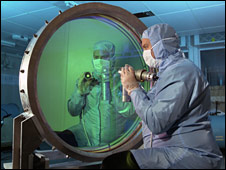
Vulcan mirror
The UK plans to build an even more powerful facility called Hiper:
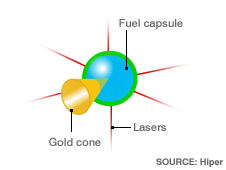
1. Powerful lasers irradiate a fuel capsule causing the outer layer
to rapidly expand.
a comparison of long and short skirt sizes
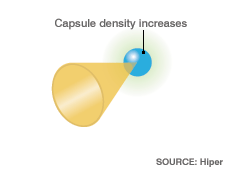
2. The fuel capsule's core increases in density, converging at the
tip of a gold cone.
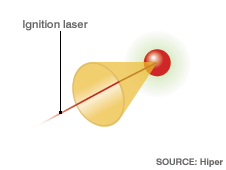
3. An intense ignition laser is fired into the gold cone producing
energetic electrons.
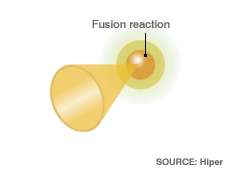
4. Electrons bombard the fuel raising its temperature to 100 million
Celsius, initiating fusion.
|
The Vulcan laser concentrated energy equivalent
to 100 times the world's electricity production into a spot just a few
millionths of a metre across.
Writing in the New Journal of Physics, scientists
said they could create the conditions for fractions of a second.
The experiments demonstrated concepts which
could be key to building a future nuclear fusion reactor.
The UK has proposed an even more powerful
laser facility, known as Hiper (High Power laser Energy Research), which
will study the feasibility of laser fusion as a potential future energy
source.
"Hiper is a proposed, very large-scale
facility and so we have to check that our understanding is correct,"
explained Professor Peter Norreys of the Rutherford Appleton Laboratory
(RAL) in Oxfordshire where the experiments took place.
Extreme condition
Nuclear fusion is looked on as a panacea in
a world that demands ever increasing amounts of energy.
The fuel for the process is deuterium and
tritium, two heavier forms of hydrogen that are commonly found in seawater.
When these isotopes are combined at high temperatures,
a small amount of mass is lost and a colossal amount of energy is released.
By-products are no more radioactive than hospital waste.
The process naturally occurs in the core of
the Sun where huge gravitational pressure allows this to happen at temperatures
of around 10 million Celsius.
At the much lower pressures on Earth, temperatures
to produce fusion would need to be much higher - above 100 million Celsius.
Ultra powerful lasers, such as Hiper, have
been proposed as one method for reaching these extreme conditions, although
many remain sceptical about the technique.
The project has been drawn up to capitalise
on another project at the National Ignition Facility (NIF) at the Lawrence
Livermore National Laboratory in California.
NIF is expected to demonstrate energy production from laser driven
fusion between 2010 and 2012.
If proven, the technology could rival the
current favoured technique for initiating fusion which uses superconducting
magnets to contain and fuse the hydrogen nuclei.
This technique will be used in the 10bn-euro
International Thermonuclear Experimental Reactor (Iter) currently being
built in Cadarache, southern France.
Energy boost
The new work laid some of the foundations
for Hiper.
In the experiments, the Vulcan laser focused
one petawatt (1,000 trillion watts) of power into a spot about one tenth
of the width of a human hair.
The pulse lasted for one picosecond (one trillionth
of a second), heating the target to 10 million Celsius, one tenth of that
required for nuclear fusion.
However, even at these relatively balmy temperatures,
the conditions were equivalent to these found in supernova explosions.
A special high-speed camera probed the fleeting
moment.
"We wanted to understand the basic interaction
of matter with these laser pulses," Professor Norreys told BBC News.
Specifically, the team wanted to understand
how much energy was transferred from the laser to the target.
"Efficient coupling of the laser energy
to the target is crucial for fast ignition fusion, and is one of the main
questions on which the design of… Hiper depends," said Dr Jonathan
Davies from Instituto Superior Technico, Lisbon, Portugal, who also took
part in the study. |
 NUCLEAIRES !
NUCLEAIRES ! NUCLEAIRES !
NUCLEAIRES !